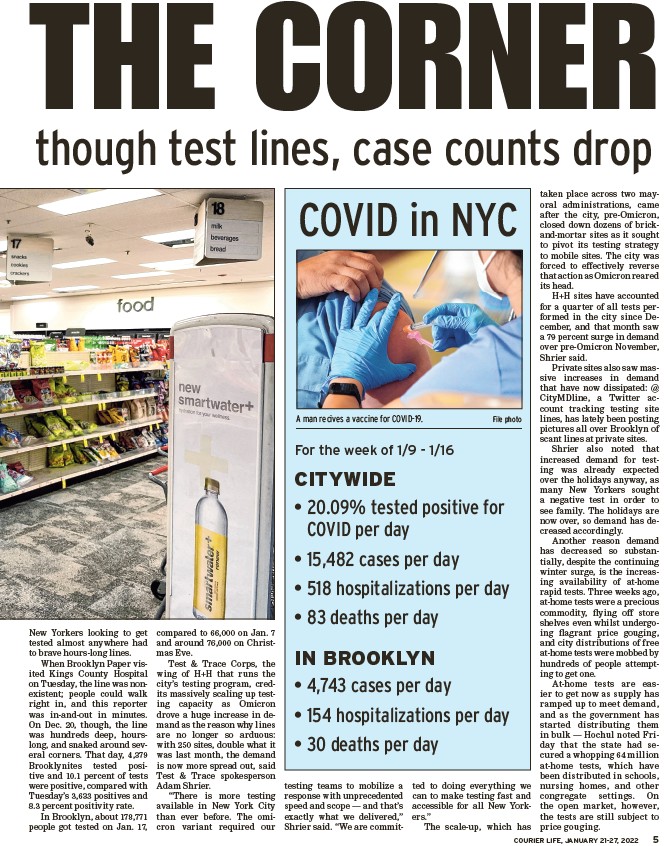
THE CORNER
though test lines, case counts drop
COVID in NYC
A man recives a vaccine for COVID-19. File photo
COURIER LIFE, JANUARY 21-27, 2022 5
New Yorkers looking to get
tested almost anywhere had
to brave hours-long lines.
When Brooklyn Paper visited
Kings County Hospital
on Tuesday, the line was nonexistent;
people could walk
right in, and this reporter
was in-and-out in minutes.
On Dec. 20, though, the line
was hundreds deep, hourslong,
and snaked around several
corners. That day, 4,379
Brooklynites tested positive
and 10.1 percent of tests
were positive, compared with
Tuesday’s 3,633 positives and
8.3 percent positivity rate.
In Brooklyn, about 178,771
people got tested on Jan. 17,
compared to 66,000 on Jan. 7
and around 76,000 on Christmas
Eve.
Test & Trace Corps, the
wing of H+H that runs the
city’s testing program, credits
massively scaling up testing
capacity as Omicron
drove a huge increase in demand
as the reason why lines
are no longer so arduous:
with 250 sites, double what it
was last month, the demand
is now more spread out, said
Test & Trace spokesperson
Adam Shrier.
“There is more testing
available in New York City
than ever before. The omicron
variant required our
testing teams to mobilize a
response with unprecedented
speed and scope — and that’s
exactly what we delivered,”
Shrier said. “We are committed
to doing everything we
can to make testing fast and
accessible for all New Yorkers.”
The scale-up, which has
taken place across two mayoral
administrations, came
after the city, pre-Omicron,
closed down dozens of brickand
mortar sites as it sought
to pivot its testing strategy
to mobile sites. The city was
forced to effectively reverse
that action as Omicron reared
its head.
H+H sites have accounted
for a quarter of all tests performed
in the city since December,
and that month saw
a 79 percent surge in demand
over pre-Omicron November,
Shrier said.
Private sites also saw massive
increases in demand
that have now dissipated: @
CityMDline, a Twitter account
tracking testing site
lines, has lately been posting
pictures all over Brooklyn of
scant lines at private sites.
Shrier also noted that
increased demand for testing
was already expected
over the holidays anyway, as
many New Yorkers sought
a negative test in order to
see family. The holidays are
now over, so demand has decreased
accordingly.
Another reason demand
has decreased so substantially,
despite the continuing
winter surge, is the increasing
availability of at-home
rapid tests. Three weeks ago,
at-home tests were a precious
commodity, fl ying off store
shelves even whilst undergoing
fl agrant price gouging,
and city distributions of free
at-home tests were mobbed by
hundreds of people attempting
to get one.
At-home tests are easier
to get now as supply has
ramped up to meet demand,
and as the government has
started distributing them
in bulk — Hochul noted Friday
that the state had secured
a whopping 64 million
at-home tests, which have
been distributed in schools,
nursing homes, and other
congregate settings. On
the open market, however,
the tests are still subject to
price gouging.
For the week of 1/9 - 1/16
CITYWIDE
• 20.09% tested positive for
COVID per day
• 15,482 cases per day
• 518 hospitalizations per day
• 83 deaths per day
IN BROOKLYN
• 4,743 cases per day
• 154 hospitalizations per day
• 30 deaths per day